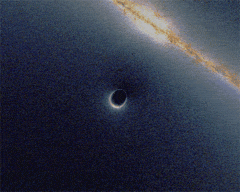
Gravitational singularity
A gravitational singularity, spacetime singularity or simply singularity is a condition in which gravity is predicted to be so intense that spacetime itself would break down catastrophically. As such, a singularity is by definition no longer part of the regular spacetime and cannot be determined by "where" or "when". Gravitational singularities exist at a junction between general relativity and quantum mechanics; therefore, the properties of the singularity cannot be described without an established theory of quantum gravity. Trying to find a complete and precise definition of singularities in the theory of general relativity, the current best theory of gravity, remains a difficult problem.[1][2] A singularity in general relativity can be defined by the scalar invariant curvature becoming infinite[3] or, better, by a geodesic being incomplete.[4]
Gravitational singularities are mainly considered in the context of general relativity, where density would become infinite at the center of a black hole without corrections from quantum mechanics, and within astrophysics and cosmology as the earliest state of the universe during the Big Bang. Physicists have not reached a consensus about what actually happens at the extreme densities predicted by singularities (including at the start of the Big Bang).[5]
General relativity predicts that any object collapsing beyond a certain point (for stars this is the Schwarzschild radius) would form a black hole, inside which a singularity (covered by an event horizon) would be formed.[2] The Penrose–Hawking singularity theorems define a singularity to have geodesics that cannot be extended in a smooth manner.[6] The termination of such a geodesic is considered to be the singularity.
Modern theory asserts that the initial state of the universe, at the beginning of the Big Bang, was a singularity.[7] In this case, the universe did not collapse into a black hole, because currently-known calculations and density limits for gravitational collapse are usually based upon objects of relatively constant size, such as stars, and do not necessarily apply in the same way to rapidly expanding space such as the Big Bang. Neither general relativity nor quantum mechanics can currently describe the earliest moments of the Big Bang,[8] but in general, quantum mechanics does not permit particles to inhabit a space smaller than their Compton wavelengths.[9]
Interpretation[edit]
Many theories in physics have mathematical singularities of one kind or another. Equations for these physical theories predict that the ball of mass of some quantity becomes infinite or increases without limit. This is generally a sign for a missing piece in the theory, as in the ultraviolet catastrophe, re-normalization, and instability of a hydrogen atom predicted by the Larmor formula.
In classical field theories, including special relativity but not general relativity, one can say that a solution has a singularity at a particular point in spacetime where certain physical properties become ill-defined, with spacetime serving as a background field to locate the singularity. A singularity in general relativity, on the other hand, is more complex because spacetime itself becomes ill-defined, and the singularity is no longer part of the regular spacetime manifold. In general relativity, a singularity cannot be defined by "where" or "when".[10]
Some theories, such as the theory of loop quantum gravity, suggest that singularities may not exist.[11] This is also true for such classical unified field theories as the Einstein–Maxwell–Dirac equations. The idea can be stated in the form that, due to quantum gravity effects, there is a minimum distance beyond which the force of gravity no longer continues to increase as the distance between the masses becomes shorter, or alternatively that interpenetrating particle waves mask gravitational effects that would be felt at a distance.
Motivated by such philosophy of loop quantum gravity, recently it has been shown[12] that such conceptions can be realized through some elementary constructions based on the refinement of the first axiom of geometry, namely, the concept of a point [13]
by considering Klein's prescription of accounting for the extension of a small spot that represents or demonstrates a point,[14] which was a programmatic call that he called as a fusion of arithmetic and geometry.[15] Klein's program, according to Born, was actually a mathematical route to consider 'natural uncertainty in all observations' while describing 'a physical situation' by means of 'real
numbers'.[16]